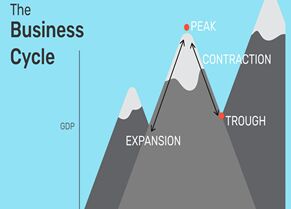商业周期包括哪几个阶段?
|
Parkin and Bade's text Economics gives the following definition of the business cycle: "The business cycle is the periodic but irregular up-and-down movements in economic activity, measured by fluctuations in real GDP and other macroeconomic variables."
To put it simply, the business cycle is defined as the real fluctuations in economic activity and gross domestic product (GDP) over a period of time. The fact that the economy experiences these ups-and-downs in activity should be no surprise. In fact, all modern industrial economies like that of the United States endure considerable swings in economic activity over time. The ups may be marked by indicators like high growth and low unemployment while the downs are generally defined by low or stagnant growth and high unemployment. Given its relationship to the phases of the business cycle, unemployment is but one of the various economic indicators used to measure economic activity. For most detailed information about how various economic indicators and their relationship to the business cycle, check out A Beginner's Guide to Economic Indicators. Parkin and Bade go on to explain that despite the name, the business cycle is not a regular, predictable, or repeating the cycle. Though its phases can be defined, its timing is random and, to a large degree, uNPRedictable. The Phases of the Business Cycle While no two business cycles are exactly the same, they can be identified as a sequence of four phases that were classified and studied in their most modern sense by American e·conomists Arthur Burns and Wesley Mitchell in their text "Measuring Business Cycles." The four primary phases of the business cycle include: Expansion: A speedup in the pace of economic activity defined by high growth, low unemployment, and increasing prices. The period marked from trough to peak. Peak: The upper turning point of a business cycle and the point at which expansion turns into contraction. Contraction: A slowdown in the pace of economic activity defined by low or stagnant growth, high unemployment, and declining prices. It is the period from peak to trough. Trough: The lowest turning point of a business cycle in which a contraction turns into an expansion. This turning point is also called Recovery. These four phases also make up what is known as the "boom-and-bust" cycles, which are characterized as business cycles in which the periods of expansion are swift and the subsequent contraction is steep and severe. But What About Recessions? A recession occurs if a contraction is severe enough. The National Bureau of Economic Research (NBER) identifies a recession as a contraction or significant decline in economic activity "lasting more than a few months, normally visible in real GDP, real income, employment, industrial production." Along the same vein, a deep trough is called a slump or a depression. The difference between a recession and a depression, which is not well-understood by non-economists, is explained in this helpful guide: Recession? Depression? What's the difference? The Great Recession The Great Recession was a period of general economic decline observed in world markets during the late 2000s and early 2010s. The scale and timing of the recession varied from country to country. The International Monetary Fund concluded that the overall impact was the most severe since the Great Depression in the 1930s. The Great Recession stemmed from collapse of the United States real-estate market, in relation to the financial crisis of 2007 to 2008 and U.S. subprime mortgage crisis of 2007 to 2009, though policies of other nations contributed also. According to the U.S. National Bureau of Economic Research (the official arbiter of U.S. recessions) the US recession began in December 2007 and ended in June 2009, thus extending over 19 months. The Great Recession resulted in the scarcity of valuable assets in the market economy and the collapse of the financial sector (banks) in the world economy. The banks were then bailed out by the U.S. government. |









